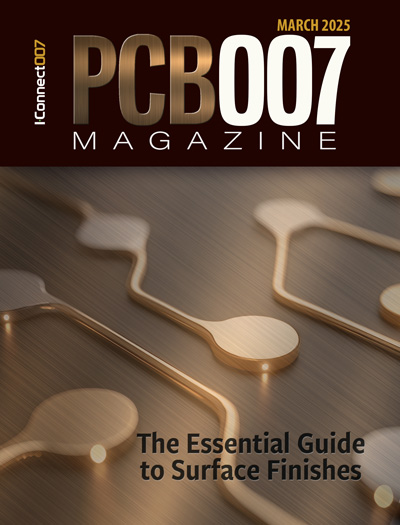-

- News
- Books
Featured Books
- pcb007 Magazine
Latest Issues
Current Issue
In Pursuit of Perfection: Defect Reduction
For bare PCB board fabrication, defect reduction is a critical aspect of a company's bottom line profitability. In this issue, we examine how imaging, etching, and plating processes can provide information and insight into reducing defects and increasing yields.

Voices of the Industry
We take the pulse of the PCB industry by sharing insights from leading fabricators and suppliers in this month's issue. We've gathered their thoughts on the new U.S. administration, spending, the war in Ukraine, and their most pressing needs. It’s an eye-opening and enlightening look behind the curtain.

The Essential Guide to Surface Finishes
We go back to basics this month with a recount of a little history, and look forward to addressing the many challenges that high density, high frequency, adhesion, SI, and corrosion concerns for harsh environments bring to the fore. We compare and contrast surface finishes by type and application, take a hard look at the many iterations of gold plating, and address palladium as a surface finish.
- Articles
- Columns
Search Console
- Links
- Media kit
||| MENU - pcb007 Magazine
IMAPS’ Annual Conference Opener in Phoenix ‘Blew My Mind’
March 5, 2025 | Marcy LaRont, I-Connect007Estimated reading time: 4 minutes
It was a cool and sunny morning as I headed out to the IMAPS Device Packaging Conference 2025 in Arizona early Tuesday, which featured two compelling keynote speakers, and a day chocked full of technical sessions. IMAPS 2025 also hosted a sold-out exhibit hall with 65 exhibitors from IBM and Heraeus to Cadence and KYZEN, to name just a few. The technology and packaging discussions at this conference blew my mind last year, and it is clear this year would be no different.
The first keynote speaker was Dr. Hemanth Jagannathan of IBM with his presentation, “Chiplet and Advanced Packaging Solutions in the Era of AI.” He first honored packaging pioneers from 1947 to the present: Jack Kilby, Robert Noyce, Gordon Moore, Bob Dennard, John Bardeen, William Shockley, and Walter Brattain. He stated emphatically that this is the time for advanced packaging to shine. He then discussed IBM’s own history and its Thermal Conduction Module (TCM). “TCM in the 1980s was a breakthrough in packaging technology, eliminating wiring congestion,” he said, adding that it saved the day for semiconductor packaging needs at that time, enabling the next generation of chip technology.
Clearly, we are in another technology-straining time as AI pushes all boundaries in both hardware and software. To illustrate the tremendous load of AI computational demand, he offered that the computational demand for training Chat GPT today takes the same amount of data processing as three roundtrip jetliner trips from New York to San Francisco. That’s mind-boggling. “AI demand is not stopping,” he said. “It’s growing, and market demand is unsustainable” at the moment, given our existing capabilities and solutions. In short, we have many challenges to overcome.
Highlighting the need for new solutions, he broke down IBM’s chiplet platform to enable AIU innovation: node optimization and die disaggregation, the latter of which addresses the issues of both cost and modularity in modern chip packaging architecture. He said that computation memory and connectivity are the three basics for AI hardware, and to achieve them all provides the flexibility needed to solve problems and no longer be “shackled by architecture (limitations).”
“What we are doing now is akin to a complete organ transplant,” he declared. Where we find ourselves today in the packaging arena is at another level entirely. Jagannathan entreated the audience to co-create the needed solutions with IBM and others.
The second keynote of the morning was presented by Sun Jin Kim, PhD, and CEO of Absolics, a semiconductor packaging group based in Georgia, and founded in 2021 as a spin off from Korean parent company, SKC. He began his presentation, “Breaking Barriers in Semiconductor Packaging: Leveraging Glass-Based Substrates for Superior Connectivity,” with a general call-out. “We know the driver of advanced packaging is artificial intelligence (AI),” he said, “but we have some topics to develop and discuss. Currently, advanced packaging has too many interfaces and a complicated supply chain.”
He said the full landscape of software suppliers, OSATs, EDA companies, and material providers all have to develop and this delays progress of the advanced packaging industry. Kim restated the need for out-of-the-box solutions that provide more functionality, more bandwidth, higher performance and technology scalability, while also achieving lower energy consumption, shorter development cycle times, and reasonable costs.
Absolics was awarded a $75 million grant through the U.S. CHIPS Act. The company’s solution revolves around glass, something we have heard about from the old days at Hewlett Packard.
Absolics’ glass substrates achieve a simpler packaging structure, denser RDL (traces and BVH), larger package body size, flatter conductive surface (at nanometer scale), and fewer companies (supply chain partners) needing to be involved. He called Absolics an underdog in the market, and compared his company to Steve Job’s introduction of the smartphone when Nokia clearly dominated the global cell phones market at that time.
Advantages of glass include superior electrical performance, high dimensional stability, fine-line routing capability, improved thermal stability, and higher integration potential. Its challenges are fragility (it’s brittle and breaks easily), thermal conductivity, manufacturing complexity and cost, and adoption. With that, a bullish Kim said that means there exist many opportunities for innovation and growth. According to Kim, to make a mere hundreds of panels per day takes 300 processes, something that has been developed by Absolics over roughly the past 10 years.
When asked about thickness, layers ,and reliability, Kim mentioned that the minimum thickness of glass they can deal with is 0.3 mm and the max core is 1.6 mm, with most of their work done in between, and with between 10 and 20 metal layers per side. When it comes to reliability data, there is no standard for for glass substrates at this time, but he seemed to assure the audience that Absolics work to a higher reliability standard than what would be considered the industry norm.
Finally, Kim spent some time talking about embedded components, saying that embedded components are imperative, and that only GPUs will not be able to be embedded in the next few years. “Electrons die when they travel, but if we embed components inside of the glass, the travel length becomes less than a millimeter, a lot better performance,” Kim said. “Embedding is a critical technology development to enable high performance.” He concluded with a definition of Absolics as a scaling company: scaling up form factor, scaling down supply chain, and scaling in finer connections.
After a quick break and some good coffee, I headed into the exhibit hall to see old and new friends. I am looking forward to more discussion in the coming two days on 2D and 3D heterogeneous packaging solutions, additive manufacturing, photonics and optoelectronics and, of course, further discussion around AI.
Suggested Items
Mycronic’s Global Technologies Acquires Surfx in the US
06/03/2025 | MycronicMycronic’s Global Technologies division has acquired Surfx Technologies, a company headquartered in the US, providing atmospheric plasma solutions for surface treatment, including cleaning and active oxide removal.
Siemens Expands OSAT Alliance Membership to Build Domestic Semiconductor Supply Chains
05/29/2025 | SiemensSiemens Digital Industries Software announced the latest members to join its OSAT Alliance program which enables outsourced semiconductor assembly and test (OSAT) providers to develop, validate and support integrated circuit (IC) package assembly design kits (ADKs) that drive broader adoption of emerging technologies by fabless semiconductor and systems companies and help to build secure domestic semiconductor supply chains.
Promex Industries CEO Richard Otte Honored with IEEE Electronics Manufacturing Technology Award
05/27/2025 | PromexPromex Industries, Inc., a Silicon Valley-based provider of advanced design, packaging, and microelectronics assembly services, today announced that CEO Richard (Dick) Otte has received the 2025 Electronics Manufacturing Technology Award from the IEEE Electronics Packaging Society (EPS).
ClassOne Technology, IBM Research Jointly Developing Non-NMP Solvent Processing for Semiconductor Manufacturing
05/26/2025 | ClassOne TechnologyClassOne Technology, a leading global provider of advanced electroplating and wet processing tools for microelectronics manufacturing, announced it has signed a joint development agreement with IBM Research focused on wet processing for advanced packaging.
TRI, Bosch Partner on AI Solution for MEMS Packaging
05/26/2025 | TRITest Research, Inc., the leading test and inspection systems provider for the electronics manufacturing industry, is proud to announce its successful partnership with Bosch in the development of an AI visual check solution for MEMS packaging.


